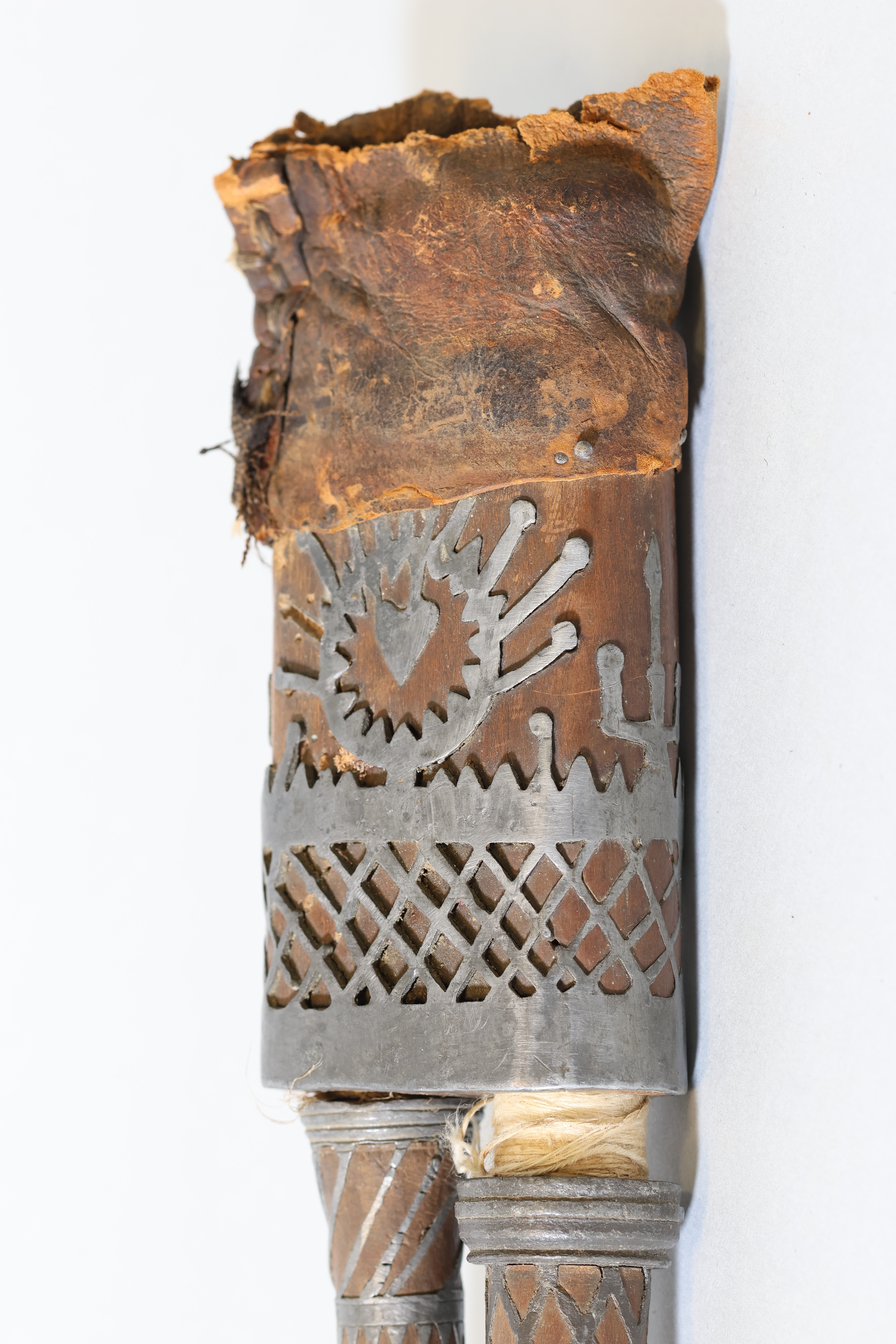Cornemuse
19th century
Not on view
This instrument is a large bagpipe inlaid with tin/pewter (cornemuse incrustée d’étain) found in the Centre of France in the eighteenth and early nineteenth centuries. These mouth-blown bagpipes feature a parallel melodic pipe and tenor drone, inserted in a common rectangular stock, as well as a separate bass drone. Bagpipe maker Bernard Blanc puts forward the theory that this type of bagpipe date from before the French revolution. His theory is based on the nature of the pewter designs, representing symbols of royalty and the church such as the fleur-de-lys, and testimonies found in nineteenth century novels and monographs (Blanc 1996:28-9). Pewter-inlaid bagpipes came in different sizes; larger ones were gradually forgotten as smaller, nimbler models took over from the mid-nineteenth century onwards, enabling more virtuosity.
This bagpipe is made of plumwood inlaid with tin/pewter. It is most likely a combination of original craftsmanship and replacement pieces, creating a composite instrument. The finest craftsmanship on this instrument is found on the middle and end section of the drone, suggesting that these are the only original pieces matching the quality of the production found in the late eighteenth century, probably between 1780 and 1800 (Blanc 1987). The rest of the bagpipe is roughly made and mismatched. The lattice work is much wider and irregular, the small drone is too short compared to the chanter (it should reach the tuning holes of the chanter). Finally, the chanter/tenor drone stock is illogically presented: the playing arrangement, with the chanter to the left of the tenor drone (evidenced by the blocked pinky hole on the left side of the chanter, showing that this bagpipe was played with the right hand at the bottom of the chanter), is the only possible arrangement: otherwise the tenor drone obstructs the final hole. However, the internal stock bores are not equal, meaning that the position of the chanter and tenor drone are not interchangeable. This playing arrangement, fitted into the stock, brings what would normally be understood as the ‘back’ of the stock (the least ornate part) to the front. While the blocked pinky hole suggests that this bagpipe might have been played, the illogical arrangement points either to the fact that this was originally made for a player that played with the right hand on top, or that the instrument is made of composite parts that do not quite fit together.
(Cassandre Balosso-Bardin, 2023)
Technical Description
Conical single chanter 420 mm, 7/1 holes, the lowest doubled with one blocked with wax, 2 vent holes, reed missing (typically, cane double reed);
Bass drone in 3 sections 712 mm, tenor drone in 2 sections 255 mm excluding tenon cylindrical bores, both drones with tuning slides, reeds missing (probably single cane reeds);
Cylindrical blowpipe 156 mm with leather flapper valve; sheep or goatskin bag without cover;
Large rectangular flat stock with 2 bored holes for chanter and tenor drone, separate cylindrical stocks for bass drone and blowpipe;
all pipes and stocks inlaid with pewter decoration, chanter stock, chanter and bass drone with lattice-work pattern, both drones with fleur-de-lys pattern; drones curve out at tuning slides;
Yellow silk ribbon tied around chanter stock.
References
Bernard Blanc, 1987. Notes in instrument file #89.4.856, September 24, 1987. Musical Instrument Department Archive, New York: Metropolitan Museum of Art.
Bernard Blanc, 1996. ‘Les cornemuses du Centre : filiation et évolution’. Les cornemuses de George Sand : Autour de Jean Sautivet, fabricant et joueur de musette dans le Berry (1976-1867). Montluçon : Musées de Montluçon.
Due to rights restrictions, this image cannot be enlarged, viewed at full screen, or downloaded.
This artwork is meant to be viewed from right to left. Scroll left to view more.





